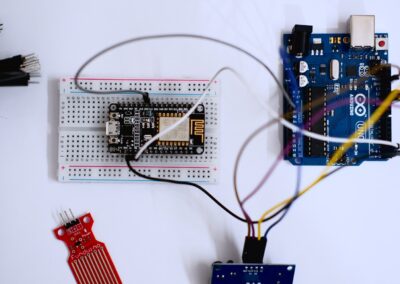Protecting Firmware Updates with Cryptographic Signatures
The Importance of Tamper-Proof Firmware
Cryptographic signatures ensure the authenticity and integrity of firmware by providing a means to verify that the update has not been tampered with. This is particularly important in regions like Saudi Arabia and the UAE, where the adoption of IoT technology is rapidly growing, necessitating advanced security protocols to protect sensitive data and infrastructure.
How Cryptographic Signatures Work
Cryptographic signatures function by generating a unique digital fingerprint for each firmware update. This fingerprint is created using a cryptographic algorithm, such as RSA or ECC, and is attached to the firmware package. When the firmware is received by an IoT device, the signature is verified using a public key that corresponds to the private key used to create the signature. If the signature matches, the firmware is deemed authentic and untampered, ensuring that only legitimate updates are applied to the device. This process is crucial for maintaining the security and reliability of IoT systems.
Verifying Signatures: Methods and Best Practices
Verifying cryptographic signatures involves several best practices to ensure effective tampering protection. One recommended method is the use of hardware security modules (HSMs) to store cryptographic keys securely. HSMs provide a robust environment for key management and signature verification, reducing the risk of key compromise. Additionally, implementing multi-factor authentication for accessing the signature verification process adds an extra layer of security. By adhering to these best practices, organizations can enhance the integrity of their IoT firmware updates and safeguard against potential cyber threats.
Enhancing IoT Security Through Advanced Cryptographic Techniques
Integrating AI and Blockchain with Cryptographic Signatures
The integration of artificial intelligence (AI) and blockchain technology with cryptographic signatures offers a multi-layered approach to IoT security. AI can be utilized to monitor firmware updates for signs of tampering or anomalies, providing real-time alerts and enabling rapid response to potential threats. Blockchain technology, with its decentralized and immutable ledger, can be used to record firmware update transactions, ensuring transparency and traceability. For cities like Riyadh and Dubai, adopting these advanced technologies can significantly enhance the security and reliability of their IoT infrastructure.
Executive Coaching and Training in IoT Security
To effectively implement cryptographic signatures and other advanced security measures, executive coaching and training are essential. Business leaders and mid-level managers must be knowledgeable about the latest cybersecurity protocols and best practices. Executive coaching services can provide tailored training programs that equip leaders with the skills needed to oversee secure IoT deployments. This proactive approach to cybersecurity education ensures that organizations remain vigilant and prepared to defend against evolving cyber threats.
Case Studies: Successful Implementation of Cryptographic Signatures
Several organizations have successfully implemented cryptographic signatures to enhance the security of their IoT devices. For example, a major healthcare provider in Saudi Arabia used cryptographic signatures to secure firmware updates for medical IoT devices, ensuring patient data integrity and compliance with regulatory standards. Similarly, a smart city project in Dubai integrated blockchain and cryptographic signatures to secure its IoT network, providing a resilient and tamper-proof infrastructure. These case studies demonstrate the practical benefits and effectiveness of cryptographic signatures in real-world IoT deployments.
Conclusion: The Future of IoT Security with Cryptographic Signatures
As IoT technology continues to evolve and expand, the importance of securing firmware updates through cryptographic signatures becomes increasingly evident. By implementing strong cryptographic algorithms and best practices for signature verification, organizations can protect their IoT devices from tampering and cyber threats. The integration of AI and blockchain further enhances this security, providing real-time monitoring and immutable records of firmware transactions. Through executive coaching and continuous training, business leaders can ensure that their IoT deployments remain secure and resilient. In regions like Saudi Arabia and the UAE, prioritizing IoT security through cryptographic signatures is essential for maintaining the integrity and reliability of their technological infrastructure.
—
#IoTSecurity #CryptographicSignatures #FirmwareUpdates #Cybersecurity #TamperingProtection #IoTDevices #AIinCybersecurity #BlockchainforIoT #ExecutiveCoaching #BusinessSuccess #LeadershipinIoT #ProjectManagement #IoTinSaudiArabia #IoTinUAE #RiyadhIoTSecurity #DubaiIoTSolutions































